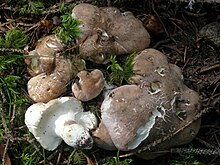|
Albatrellus ovinus
Albatrellus ovinus is a terrestrial fungus found in Europe and North America. Although commonly known as sheep polypore, this fungus is not phylogenetically related to Polyporales (shelf fungi). It similar to A. subrubescens, from which it may be distinguished microscopically. DescriptionThe cap is 4–20 centimetres (1+1⁄2–8 in) wide, convex then flat or depressed, and white then tan or pinkish. The surface is dry and smooth but cracks with age.[1] The whitish stalk is 2.5–10 cm (1–4 in) tall and 1–4 cm (3⁄8–1+5⁄8 in) wide, perhaps branching, with an equal or larger base.[1][2] The spore print is white.[2] Similar speciesThe inedible, closely related and comparatively rare Albatrellus subrubescens[3] has subtle color differences from A. ovinus, and the only spores of the former are amyloid.[4][5] Also similar are Albatrellus flettii, Jahnoporus hirtus, Scutiger ellisii, and S. pes-caprae.[1] Distribution and habitatIt is found in northern Europe and in North America. In the latter, it is found from the Pacific Northwest to Northern California, in addition to the Mountain states, the Great Lakes area, the Appalachians, and the Northeast.[2] UsesThe species may be edible if cooked, but is not recommended by some guides.[1] It is sold commercially in Finland.[6][7] References
External links
|
||||||||||||||||||||||||||||||||||||||||||||||
Portal di Ensiklopedia Dunia
